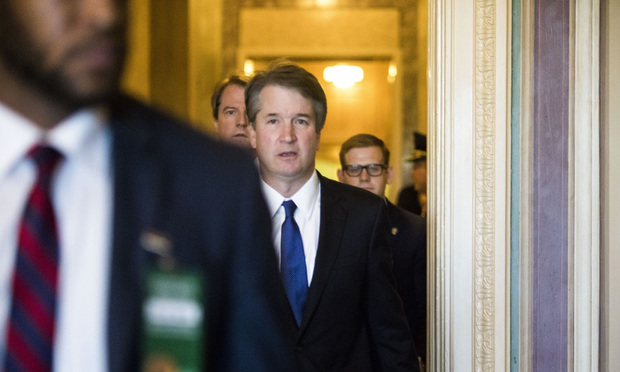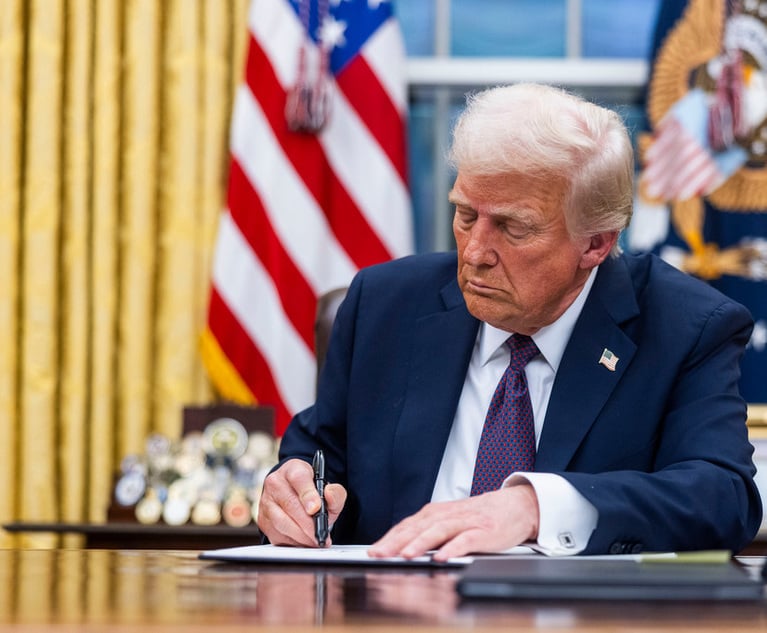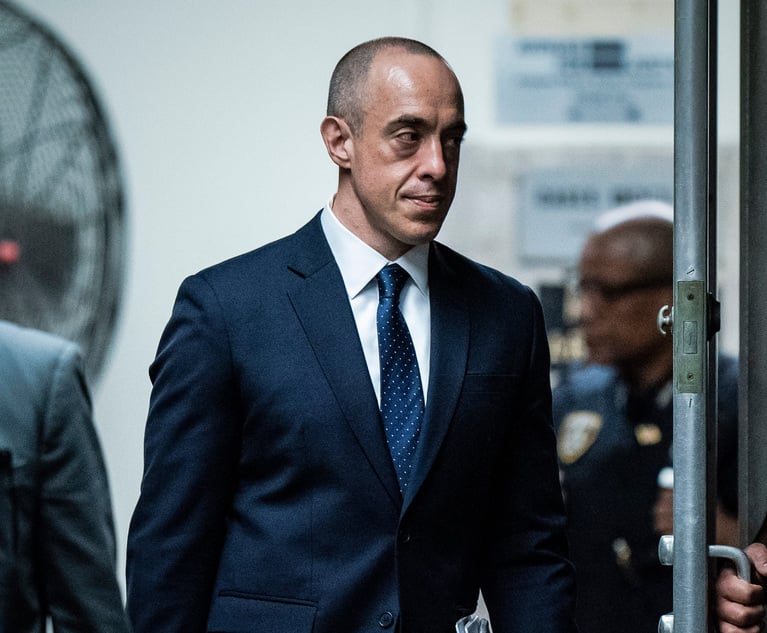As Justice, Like Circuit Judge, Kavanaugh Shows Active Style on Bench
Sitting at the far right corner of the bench, Kavanaugh chatted and laughed with his seatmate, Obama appointee Justice Elena Kagan, before arguments began. Inside the courtroom, there were no signs of his bitter confirmation proceeding.
October 09, 2018 at 12:53 PM
5 minute read
 Supreme Court nominee Judge Brett Kavanaugh walks in a hallway of the Russell Senate Office Building in July. (Photo: Diego M. Radzinschi / ALM)
Supreme Court nominee Judge Brett Kavanaugh walks in a hallway of the Russell Senate Office Building in July. (Photo: Diego M. Radzinschi / ALM)
On his first day on the bench as a U.S. Supreme Court justice, Brett Kavanaugh on Tuesday was not the most frequent questioner but showed he was fully prepared for the vexing ambiguities of a federal sentencing law—despite little time to get up to speed.
With his wife, two daughters and retired Justice Anthony Kennedy watching from special seats for guests of the justices, Kavanaugh, who was confirmed 50-48 by the Senate on Oct. 6 following a bruising confirmation process, appeared relaxed and engaged before and during two hours of oral arguments. Mike Davis, chief counsel to Senate Judiciary Chairman Chuck Grassley, who led the confirmation push, attended the argument.
Sitting at the far right corner of the bench, Kavanaugh chatted and laughed with his seatmate, Obama appointee Elena Kagan, before arguments began on what Justice Samuel Alito Jr. later would call a statute that “a majority of the court really hates,” the Armed Career Criminal Act. The night before, speaking at the White House, Kavanaugh said he would join the bench with “no bitterness” about confirmation proceedings at which his credibility and temperament were questioned.
One striking difference for Kavanaugh, who was accustomed to participating on three-judge panels at the U.S. Court of Appeals for the D.C. Circuit, was sitting with eight justices on a slightly curved bench. He often leaned forward, with neck stretched, in order to look at justices at the other end—Neil Gorsuch, Sonia Sotomayor and Stephen Breyer.
Despite the intense emotions surrounding Kavanaugh's nomination and confirmation hearings, at which Kavanaugh was accused of sexual misconduct in his high school and college years—he denied the claims—there were no attempts to protest inside the courtroom.
Outside, a small group of about 20 protesters appeared in front of the court building early in the morning, and a smaller group gathered in the rear by the underground driveway used by the justices to enter the building. The protests were mostly peaceful, with no arrests made, a police officer outside the court said. Thousands of protesters chanted outside the Supreme Court last week against Kavanaugh's nomination.
A long line of visitors snaked around the corner of the court building before the start of arguments, indicating less interest perhaps in the cases being argued than seeing Kavanaugh at work as a justice. Ruth Gronde and her 13-year-old daughter flew in from Atlanta to see Justice Ruth Bader Ginsburg and Kavanaugh's debut.
The new justice's debut was in marked contrast to Justice Neil Gorsuch's first argument day. Gorsuch, who like Kavanaugh was nominated by President Donald Trump and attended the same suburban Maryland high school, jumped right into questioning in his first case.
Gorsuch's style was deferential at times to the advocates, apologizing at one point for “taking up so much time.” But he also showed a snippish impatience when lawyers failed instantly to respond to what he was asking. “If you would just answer my question, I would be grateful,” he told one.
Gorsuch was both a frequent and persistent questioner, engaging in one case in an unusually lengthy discussion—for the Supreme Court—about standards of review and the need to follow the “plain language” of a federal statute. Since then, he has become one of the less frequent questioners on the “hot” bench with a calm and friendly style.
Kavanaugh, on the other hand, asked eight questions in two hours in a businesslike, straight-forward manner, pressing the advocates at times for more complete answers to his questions.
Kavanaugh's first case was Stokeling v. United States, in which a criminal defendant is arguing that his 1997 robbery conviction under Florida law is not a “violent felony” under the federal Armed Career Criminal Act.
The case involves ACCA's definition of violent felony, which includes the “use, attempted use or threatened use of physical force.” Probing the meaning of physical force drew a number of justices into a series of hypotheticals involving purse snatching, pinching and pulling a dollar bill from the hands of the owner—the latter actually tested in his chambers by Chief Justice John Roberts Jr.
The second argument focused on two consolidated cases: United States v. Stitt and United States v. Sims. In those cases, the justices struggled with whether burglary of a vehicle or other mobile structure qualifies as a violent felony under ACCA if the state's definition of burglary requires that the vehicle be designed or used or overnight accommodation.
Alito's frustration with the federal statute boiled over in the second argument when he said, “We have made a royal mess” of the law.
Read more:
Kavanaugh's Night at the White House: The Lawyers Inside the East Room
Kavanaugh's Supreme Court Clerk Hires in Perspective
With Kavanaugh Now Sitting, Several Big Petitions Await Action
Justice Kavanaugh May Find Rough Start With New Colleagues
Brett Kavanaugh, Neutrality Questioned, Ascends to Supreme Court
Ellis Kim contributed reporting.
This content has been archived. It is available through our partners, LexisNexis® and Bloomberg Law.
To view this content, please continue to their sites.
Not a Lexis Subscriber?
Subscribe Now
Not a Bloomberg Law Subscriber?
Subscribe Now
NOT FOR REPRINT
© 2025 ALM Global, LLC, All Rights Reserved. Request academic re-use from www.copyright.com. All other uses, submit a request to [email protected]. For more information visit Asset & Logo Licensing.
You Might Like
View All
'Something Else Is Coming': DOGE Established, but With Limited Scope

Supreme Court Considers Reviving Lawsuit Over Fatal Traffic Stop Shooting

US DOJ Threatens to Prosecute Local Officials Who Don't Aid Immigration Enforcement
3 minute read
US Judge Cannon Blocks DOJ From Releasing Final Report in Trump Documents Probe
3 minute readTrending Stories
- 1After DEI Rollbacks, Employment Lawyers See Potential For Targeting Corporate Commitment to Equality
- 2People in the News—Jan. 23, 2025—Marshall Dennehey, Duane Morris, Hangley Aronchick
- 3Fried Frank Adds Latest Goodwin Partner in London
- 4Why U.S. Big Law Was Mostly Sidelined in Asian IPOs in New York Last Year
- 5The Rise and Risks of Merchant Cash Advance Debt Relief Companies
Who Got The Work
J. Brugh Lower of Gibbons has entered an appearance for industrial equipment supplier Devco Corporation in a pending trademark infringement lawsuit. The suit, accusing the defendant of selling knock-off Graco products, was filed Dec. 18 in New Jersey District Court by Rivkin Radler on behalf of Graco Inc. and Graco Minnesota. The case, assigned to U.S. District Judge Zahid N. Quraishi, is 3:24-cv-11294, Graco Inc. et al v. Devco Corporation.
Who Got The Work
Rebecca Maller-Stein and Kent A. Yalowitz of Arnold & Porter Kaye Scholer have entered their appearances for Hanaco Venture Capital and its executives, Lior Prosor and David Frankel, in a pending securities lawsuit. The action, filed on Dec. 24 in New York Southern District Court by Zell, Aron & Co. on behalf of Goldeneye Advisors, accuses the defendants of negligently and fraudulently managing the plaintiff's $1 million investment. The case, assigned to U.S. District Judge Vernon S. Broderick, is 1:24-cv-09918, Goldeneye Advisors, LLC v. Hanaco Venture Capital, Ltd. et al.
Who Got The Work
Attorneys from A&O Shearman has stepped in as defense counsel for Toronto-Dominion Bank and other defendants in a pending securities class action. The suit, filed Dec. 11 in New York Southern District Court by Bleichmar Fonti & Auld, accuses the defendants of concealing the bank's 'pervasive' deficiencies in regards to its compliance with the Bank Secrecy Act and the quality of its anti-money laundering controls. The case, assigned to U.S. District Judge Arun Subramanian, is 1:24-cv-09445, Gonzalez v. The Toronto-Dominion Bank et al.
Who Got The Work
Crown Castle International, a Pennsylvania company providing shared communications infrastructure, has turned to Luke D. Wolf of Gordon Rees Scully Mansukhani to fend off a pending breach-of-contract lawsuit. The court action, filed Nov. 25 in Michigan Eastern District Court by Hooper Hathaway PC on behalf of The Town Residences LLC, accuses Crown Castle of failing to transfer approximately $30,000 in utility payments from T-Mobile in breach of a roof-top lease and assignment agreement. The case, assigned to U.S. District Judge Susan K. Declercq, is 2:24-cv-13131, The Town Residences LLC v. T-Mobile US, Inc. et al.
Who Got The Work
Wilfred P. Coronato and Daniel M. Schwartz of McCarter & English have stepped in as defense counsel to Electrolux Home Products Inc. in a pending product liability lawsuit. The court action, filed Nov. 26 in New York Eastern District Court by Poulos Lopiccolo PC and Nagel Rice LLP on behalf of David Stern, alleges that the defendant's refrigerators’ drawers and shelving repeatedly break and fall apart within months after purchase. The case, assigned to U.S. District Judge Joan M. Azrack, is 2:24-cv-08204, Stern v. Electrolux Home Products, Inc.
Featured Firms
Law Offices of Gary Martin Hays & Associates, P.C.
(470) 294-1674
Law Offices of Mark E. Salomone
(857) 444-6468
Smith & Hassler
(713) 739-1250










